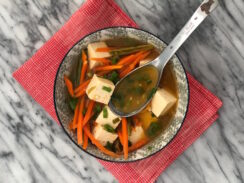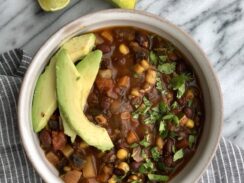EASY VEGAN HOMEMADE CURRY POWDER RECIPE
This homemade vegan curry powder is one of my favorite pantry items to have on hand given how versatile it is. It’s also super easy to make and store for several months. Cooking authentic Indian food means making a blend of whole and ground spices to get the full depth of flavor. The spices are then toasted, bringing out their aromatic oils, and ground to make this blend. Skip that overpriced store-bought curry powder as it tends to be less fresh and fragrant, and make this homemade version in just minutes!
You can use this homemade curry powder in soups, stews, curries, rice dishes, stir-fries, or even as an ingredient in a marinade. You can also sprinkle it in any savory dish that needs a boost of warmth and flavor! This recipe is the perfect balance between smoky, sweet, and spicy, but you can also make it your own and customize it with other commonly used spices that you probably already have in your pantry.
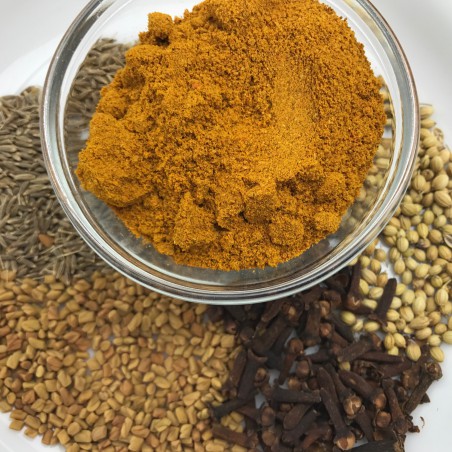
Vegan Curry Powder
Ingredients
- 3 tablespoons coriander seeds
- 2 tablespoons cumin seeds
- 2 tablespoons ground turmeric
- 1 tablespoon yellow mustard seeds
- 1 tablespoon fennel seeds
- 1 tablespoon cardamom seeds
- 1 tablespoon whole cloves
- 2 teaspoons ginger powder
- 1/4 teaspoon ground nutmeg
Instructions
- Preheat the oven to 250 degrees F and line a pan with parchment paper.
- In a bowl, combine all ingredients.
- Spread the mixture out on the prepared pan and toast for 20 minutes on the middle rack of the oven.
- Let the toasted mixture cool completely at room temperature.
- Once cool, grind the mixture in batches with a coffee bean grinder or a Vitamix at high speed.
- Strain the mixture through a small fine-mesh sieve into a bowl to get out any chunky pieces.
- Store in a tightly sealed jar in a cool, dark place for up to 2 months.
Bon appétit!
WHERE DOES CURRY ORIGINALLY COME FROM?
Curry was not commonly used in traditional Indian cuisine, nor will you find curry powder in grocery stores in India, because it was an invention by the British in the 18th century looking to replicate the flavors of Indian cooking that British colonists developed an affinity for. It was a way for people to incorporate Indian flavors into their food who would have otherwise found it difficult given how hard it was to procure all of the spices required. This classic spice blend that the British created was loosely based on the North Indian spice mix garam masala. It’s worth noting that masalas are not called curry powders but they are technically the same thing — masala simply means spice blend, which is a category that includes curry powders.
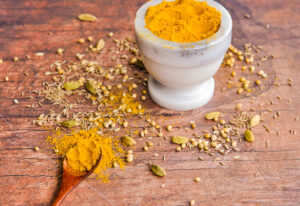
When we talk about curry in Indian cooking, we mean it as a sauce or gravy and not the actual spicing of the dish. In my home, we eat all types of curries made with vegetables and legumes, such as my Black-Eyed Pea Curry, and often serve it over basmati or jasmine rice. These curries, similar to curry powder, can be spicy or mild, depending on your heat tolerance.
You may have also heard of Thai curry, which is much heavier than Indian curry and has a very different taste profile. Thai curry contains curry paste (made with lemongrass, garlic, coriander, hot chili peppers, galangal, and shallots) and coconut milk, forming the basis of a creamy and rich sauce. Curry paste comes in red, green, and yellow varieties, accounting for the type of chili used and the level of heat desired. If you’re looking to make Thai curry at home, my delicious Thai Green Curry is made with green curry paste and loaded with tofu and vegetables.
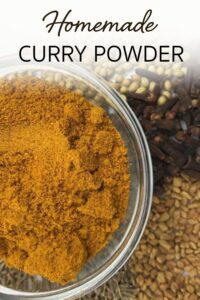
WHAT IS CURRY POWDER MADE OF AND HOW DOES IT TASTE?
Curry powder is a unique combination of spices that enhances and gives warmth to any dish it’s used in. Today you can find many diverse curry powder recipes out there, all ranging in spice strength (mild, medium, or hot) and color (red, yellow, and brown). The blends also vary in how many spices are being used, with some using only four and others using as many as 20! As far as taste goes, curry powder can be a tad bit sweet, very earthy and savory, and sometimes spicy, depending on the blend. The most common ingredients in curry powder tend to be coriander, cumin, turmeric, ginger, cardamom, and fennel. Some other ingredients that are occasionally added depending on the recipe are cinnamon, nutmeg, cloves, yellow mustard seeds, fenugreek, paprika, celery seeds, and caraway seeds. If you’re looking to take the heat up in your curry powder blend, you can use powdered chili peppers (cayenne pepper, hot paprika, ghost pepper powder) or you can try freshly ground black pepper, which will mildly increase your heat level.
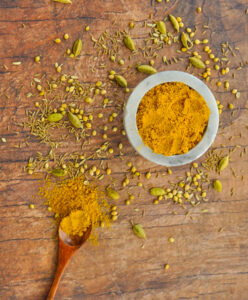
HOW DO YOU MAKE CURRY POWDER?
There are many restaurant chefs and even home cooks who prefer to make their curry powder fresh for each dish so that they can adjust the flavors and heat level, tailoring it to the meal that they’re making that day. However, my curry powder recipe can be added to pretty much any dish calling for curry powder and is worth making ahead of time to use for months to come. Follow these simple steps:
- The key to a good curry powder with complex flavor is to toast whole and ground spices before making your blend.
- Combine all of the spices on a baking sheet and spread them out in one layer. Toast them for 20 minutes at a low oven temperature to ensure that they don’t burn (250 degrees F usually works best for me).
- Let them cool completely so there’s no extra moisture and the powder will maintain longer shelf life.
- Grind the toasted spices in batches using a coffee bean grinder or Vitamix at high speed.
- Strain the mixture through a fine-mesh sieve into a bowl to remove any leftover chunky pieces.
If you’re in a pinch, a super-quick way to make very basic curry powder is to use 1 tablespoon of ground coriander, 1 tablespoon of ground cumin, and ½ a tablespoon of ground turmeric. This mixture will add a touch of warmth to any savory dish.
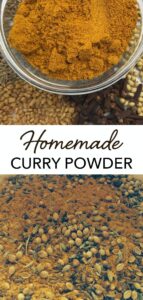
HEALTH BENEFITS OF CURRY POWDER
The spices used to make curry powder not only provide immense flavor, they also contain tons of vitamins and minerals and are surprisingly full of health benefits. Turmeric, a major player in most curry powders, has been clinically proven as a strong anti-inflammatory and anti-cancer agent due to its curcumin content. Curcumin has been studied for the last 50 years as a compound used to prevent blood sugar spikes, improving insulin sensitivity among many other benefits. Cinnamon is another spice commonly used in curry powder and has gained notoriety for relieving an upset stomach. Curry powder has an impressive impact on health and is so easy to incorporate into your savory meals!
